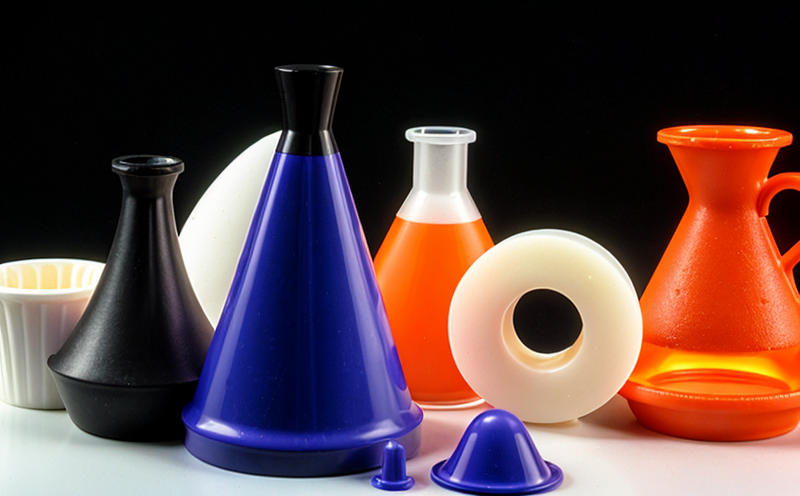EPA 8270 Organic Additive Testing in Polymer Matrices
The EPA Method 8270 is a widely recognized standard procedure used to determine organic compounds, including solvents, plasticizers, and other additives present within polymer matrices. This method is crucial for ensuring compliance with environmental regulations and providing accurate data that informs product safety and sustainability.
The process involves the extraction of organic components from solid or semi-solid materials using a solvent system followed by thermal desorption in a capillary column gas chromatograph (GC). The extracted compounds are then identified through mass spectrometry (MS) analysis. This approach ensures comprehensive coverage of even trace amounts of contaminants, which is essential for assessing potential risks associated with the use of these polymers.
Compliance to this method guarantees that manufacturers can demonstrate adherence to regulatory requirements set forth by environmental agencies such as the U.S. Environmental Protection Agency (EPA) and other international bodies like ISO or ASTM. By leveraging our expertise in conducting EPA 8270 tests, businesses not only meet legal obligations but also enhance their reputation by showcasing commitment to responsible practices.
Our lab offers a range of services tailored specifically towards this methodology, including sample preparation, extraction techniques, and detailed reporting based on the findings. We employ state-of-the-art equipment capable of delivering precise results with minimal error rates, ensuring confidence in the outcomes produced. Additionally, our team comprises highly skilled professionals who possess extensive knowledge regarding current methodologies employed within the industry.
- Extracts organic compounds from polymer matrices
- Analyzes extracted samples via GC-MS instrumentation
- Provides comprehensive reports aligned with applicable regulations
- Ensures accurate identification of all detected substances
The importance of this testing cannot be overstated, especially given its role in informing decisions about material selection and process optimization. By utilizing EPA 8270 compliant methods during R&D phases or quality control checks post-production, companies can ensure they are operating ethically while maintaining high standards of product integrity.
Understanding the implications of various additives on polymer performance is key to developing innovative solutions that meet both regulatory and commercial demands. Our team works closely with clients throughout every stage of testing to provide tailored recommendations based on our findings, helping them stay ahead of changing industry trends and regulatory expectations.
Applied Standards
The EPA Method 8270 is recognized internationally for its ability to accurately detect organic additives in polymer matrices. This method aligns with several other standards such as ISO, ASTM, and EN specifications which emphasize similar principles of sample preparation, extraction techniques, and analytical approaches.
- ISO 17534:2016 - Organic Solvents in Polymeric Materials
- ASTM D897-17e1 Standard Test Method for Determining Volatile Organic Compounds (VOCs) in Plastics by Head Space Techniques
- EN 13452:2018 - Analysis of VOCs in Plastic Materials by Headspace Technique and Capillary Gas Chromatography-Mass Spectrometry
These standards collectively provide a robust framework for ensuring consistent and reliable results across different laboratories worldwide. Compliance with these guidelines ensures that the testing conducted adheres to internationally accepted practices, thereby enhancing credibility among stakeholders.
Customer Impact and Satisfaction
Implementing EPA 8270 organic additive testing in polymer matrices offers numerous benefits for businesses operating within this sector. One of the primary advantages is improved product quality assurance, as it allows companies to identify potential issues early on in the production process before they become costly problems downstream.
- Identifies problematic additives that may lead to degradation over time
- Ensures compliance with local and international regulatory requirements
- Promotes transparency between suppliers and customers regarding product composition
In addition, by adopting this method early in the design phase or during routine quality checks, firms can avoid costly recalls and reputational damage associated with non-compliance incidents. This proactive approach fosters trust among end-users who value eco-friendly products made using sustainable practices.
Competitive Advantage and Market Impact
Adopting EPA Method 8270 for organic additive testing in polymer matrices provides significant competitive advantages that can drive business growth. One major benefit is the ability to stay ahead of regulatory changes by continuously monitoring emerging contaminants and ensuring ongoing compliance.
- Pioneers innovation through advanced analytical techniques
- Facilitates better decision-making regarding material selection
- Enhances brand reputation as a leader in sustainability efforts
Moreover, compliance with this method enhances market access opportunities for businesses operating globally. As more regions adopt stringent environmental policies, having reliable data from EPA 8270 testing can differentiate your offerings from competitors who may lack similar certifications.





